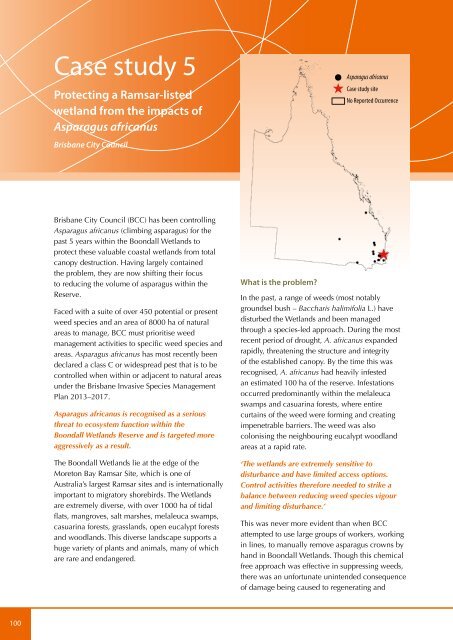Asparagus weeds - Weeds Australia
Asparagus weeds - Weeds Australia
Asparagus weeds - Weeds Australia
- No tags were found...
Create successful ePaper yourself
Turn your PDF publications into a flip-book with our unique Google optimized e-Paper software.
Case study 5Protecting a Ramsar-listedwetland from the impacts of<strong>Asparagus</strong> africanusBrisbane City Council! <strong>Asparagus</strong> africanus^Case study siteNo Reported OccurrenceBrisbane City Council (BCC) has been controlling<strong>Asparagus</strong> africanus (climbing asparagus) for thepast 5 years within the Boondall Wetlands toprotect these valuable coastal wetlands from totalcanopy destruction. Having largely containedthe problem, they are now shifting their focusto reducing the volume of asparagus within theReserve.Faced with a suite of over 450 potential or presentweed species and an area of 8000 ha of naturalareas to manage, BCC must prioritise weedmanagement activities to specific weed species andareas. <strong>Asparagus</strong> africanus has most recently beendeclared a class C or widespread pest that is to becontrolled when within or adjacent to natural areasunder the Brisbane Invasive Species ManagementPlan 2013–2017.<strong>Asparagus</strong> africanus is recognised as a seriousthreat to ecosystem function within theBoondall Wetlands Reserve and is targeted moreaggressively as a result.The Boondall Wetlands lie at the edge of theMoreton Bay Ramsar Site, which is one of<strong>Australia</strong>’s largest Ramsar sites and is internationallyimportant to migratory shorebirds. The Wetlandsare extremely diverse, with over 1000 ha of tidalflats, mangroves, salt marshes, melaleuca swamps,casuarina forests, grasslands, open eucalypt forestsand woodlands. This diverse landscape supports ahuge variety of plants and animals, many of whichare rare and endangered.What is the problem?In the past, a range of <strong>weeds</strong> (most notablygroundsel bush – Baccharis halimifolia L.) havedisturbed the Wetlands and been managedthrough a species-led approach. During the mostrecent period of drought, A. africanus expandedrapidly, threatening the structure and integrityof the established canopy. By the time this wasrecognised, A. africanus had heavily infestedan estimated 100 ha of the reserve. Infestationsoccurred predominantly within the melaleucaswamps and casuarina forests, where entirecurtains of the weed were forming and creatingimpenetrable barriers. The weed was alsocolonising the neighbouring eucalypt woodlandareas at a rapid rate.‘The wetlands are extremely sensitive todisturbance and have limited access options.Control activities therefore needed to strike abalance between reducing weed species vigourand limiting disturbance.’This was never more evident than when BCCattempted to use large groups of workers, workingin lines, to manually remove asparagus crowns byhand in Boondall Wetlands. Though this chemicalfree approach was effective in suppressing <strong>weeds</strong>,there was an unfortunate unintended consequenceof damage being caused to regenerating and100
















